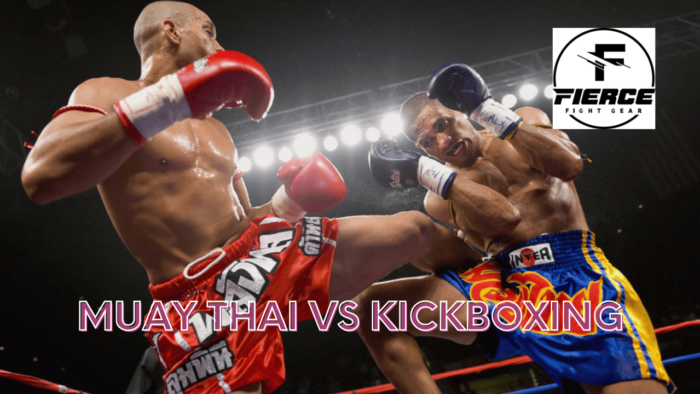When it comes to combat sports, Muay Thai and Kickboxing are two names that often come up. Both involve striking techniques, but what sets them apart? In this article, we’ll break down the differences between Muay Thai and Kickboxing, and take a good look at their histories, fighting styles, and their relevance to self-defense. So, let’s look into both combat sports without further ado: Muay Thai vs Kickboxing!
Muay Thai vs Kickboxing: What is Muay Thai?
Muay Thai, also known as Thai boxing, is a captivating combat sport with its roots firmly planted in the heart of Thailand. It’s not just a sport; it’s a martial art that focuses on striking techniques. Muay Thai practitioners use a combination of their fists, elbows, knees, and shins to engage in this dynamic martial art. It’s like a symphony of powerful strikes that require skill and precision.
In Muay Thai, fighters are trained extensively in various striking techniques, making it a well-rounded martial art. But that’s not all. Muay Thai also introduces something unique to the mix – the clinch work. This is a technique used in Muay Thai where fighters get up close and personal with their opponents, grappling and maneuvering for control. A Muay Thai fight is like a chess match in the middle of a fight, requiring strategy and finesse.
Muay Thai vs Kickboxing: History of Muay Thai
Muay Thai isn’t just a sport; it’s a piece of Thailand’s rich history. Its origins can be traced back many centuries. Initially, it wasn’t about sport or competition; it was born as a means of self-defense for Thai warriors. Picture ancient warriors standing tall and ready to protect their land using the techniques that would eventually become Muay Thai.
Over the years, Muay Thai evolved. It transformed from a practical self-defense system into a fully-fledged sport with its own set of rules and competitions. This transformation didn’t erase its deep connection to Thai culture; instead, it became an integral part of it. Today, Muay Thai is not just practiced in Thailand but has spread its influence worldwide, captivating people with its blend of tradition, discipline, and athleticism. It’s a testament to how a martial art can transcend time and borders, keeping its roots intact while evolving to fit the modern world.
Muay Thai vs Kickboxing: What is Kickboxing?
Kickboxing, like Muay Thai, is a striking combat sport that involves powerful punches and kicks. However, it has its roots in two different worlds: Japanese karate and Western boxing. This unique blend gives kickboxing its distinct flavor in the world of combat sports.
In kickboxing, kickboxers rely on a combination of well-executed punches and kicks to engage with their opponents. It’s like a dance of precision and timing, where each move is a potential game-changer. Unlike Muay Thai, kickboxing doesn’t incorporate elbow or knee strikes into its arsenal of techniques. Instead, it focuses on honing the art of punching, kicking, and good footwork to perfection.
Muay Thai vs Kickboxing: History of Kickboxing
The story of kickboxing is relatively recent compared to its ancient counterpart, Muay Thai. It’s a tale that unfolds in the 1960s and 1970s when martial artists from diverse backgrounds decided to create something new and exciting. They sought to blend the best elements of various martial arts to form a hybrid sport – kickboxing.
This innovative sport quickly gained popularity, spreading its influence to different corners of the globe. As it traveled, it took on different forms and rule sets, adapting to the preferences of different cultures. You might have heard of American kickboxing, which has its own unique set of rules, or Dutch kickboxing, Japanese kickboxing, famously known as K-1.
Kickboxing’s journey is a testament to the human spirit of exploration and creativity. It’s a sport that was born out of the desire to combine the best of different martial arts, resulting in an electrifying combat sport that continues to captivate audiences worldwide.
Muay Thai vs Kickboxing: Difference between Muay Thai and Kickboxing

Now that we understand the basics of both combat sports, let’s take a look at the difference between the two sports.
Striking Techniques
In Muay Thai, fighters utilize a diverse range of striking techniques, including punches, kicks, elbows, and knees (eight-point striking system). This variety makes it a comprehensive striking martial art. In contrast, kickboxers focus primarily on punches and kicks, omitting the use of elbows and knees. This means kickboxing is a four-point striking system.
Clinch Work
Muay Thai uses a unique aspect known as clinching, a close-range grappling technique. Fighters use clinching to control their opponent’s movements, land strikes, and gain positional advantage. Kickboxing, on the other hand, does not incorporate clinching into its fighting style.
Attire
Both Muay Thai and kickboxing share similar attire, such as gloves and shorts, which allow for freedom of movement during fights. However, Muay Thai fighters often wear a distinctive armband called a “Mongkol” as part of their traditional attire, symbolizing respect and tradition.
Scoring
The scoring systems in Muay Thai and kickboxing differ in their emphasis. In Muay Thai, judges take into account a broader range of strikes, including elbows, knees, and effective clinching. This diversity in scoring reflects the sport’s comprehensive nature whereas kickboxing has a scoring system that typically places more emphasis on punches and kicks.
Use of Knees and Elbows
One of the most notable distinctions is that Muay Thai permits an eight-point striking system and allows the use of knees and elbows as part of its striking repertoire. These powerful and versatile techniques add depth to the art. In contrast, most forms of kickboxing do not allow fighters to utilize knees and elbows during their matches.
Rules
Muay Thai’s traditional rules offer a wider spectrum of allowable strikes, embracing its rich heritage. Conversely, kickboxing often adheres to stricter rules depending on its style or organization. These rules can limit certain types of strikes and techniques. Here is a quick overview of the rules for each MMA combat sport.
Rules | Muay Thai | Kickboxing |
Striking Techniques | Punches, kicks, elbows, knees | Punches and kicks |
Clinching | Allowed, includes close-range grappling | Generally not allowed, fighters separated |
Use of Elbows/Knees | Allowed for striking | Typically not allowed for striking |
Scoring | Considers a broad range of strikes | Primarily emphasizes scoring punches and kicks |
Attire | Similar attire with “Mongkol” armband option | Similar attire with gloves and shorts |
Counting | Knockdowns result in a count by the referee | Knockdowns may result in a count by the referee |
These differences highlight the unique characteristics of each martial art and offer practitioners and enthusiasts a choice based on their preferences and goals within the two martial arts.
Muay Thai vs Kickboxing: Which of both combat sports is better for self-defense?
When considering self-defense, Muay Thai can offer a more versatile skill set. This is primarily due to its inclusion of elbow and knee strikes, as well as clinch work. These additional techniques can be advantageous in real-world self-defense situations where you may need to adapt to various scenarios.
The effectiveness of any martial art, including Muay Thai, in self-defense ultimately depends on the individual’s training and the specific circumstances they may encounter. Proper self-defense training should focus not only on striking techniques but also on situational awareness, de-escalation tactics, and understanding legal implications.
Read Also: Exploring Different Types of Martial Arts: Top 10 Martial Arts Styles
Best Protective Wear For All Combat Sports | Fierce Fight Gear
Regardless of whether you choose Muay Thai or kickboxing, investing in the right protective gear is crucial for your safety during training and competition. Fierce Fight Gear offers a comprehensive range of high-quality, customizable protective equipment designed to keep combat sports practitioners safe and comfortable.
Here are some essential protective gear items you should consider:
- Gloves: Proper boxing gloves provide hand protection and wrist support during striking sessions.
- Groin Guards: Protects the groin area from accidental strikes during training or competition.
- Headgear: Helps reduce the risk of head injuries during training and fights.
Fierce Fight Gear is committed to providing durable and reliable protective gear for combat sports enthusiasts. You can also get customizable t-shirts, shorts, jackets, and more. Investing in quality equipment ensures both your safety and longevity in your chosen martial art, whether it’s Muay Thai or kickboxing.
What’s the difference between Muay Thai and Kickboxing? I’m sure you know the answer to this question now. Remember that the common difference between both combat sports is that Muay Thai is an eight-point striking system and kickboxing fights use a four-point striking system. If you are thinking of starting a journey into one of the mixed martial arts, then you can make the right choice today.
Is there a difference between Muay Thai and kickboxing?
Yes, there are several differences, including the range of striking techniques, the inclusion of clinch work in Muay Thai, and the allowance of elbows and knees.
Will kickboxing help in a street fight?
Boxing and Kickboxing can provide valuable self-defense skills, but it’s important to remember that street fights are unpredictable, and avoiding confrontation whenever possible is the best approach.
Can you lose weight with Muay Thai?
Yes, Muay Thai is an excellent form of exercise that can help with weight loss, as it combines intense cardio with strength training.
Can you use knees in kickboxing?
In most forms of kickboxing, knees are not allowed. Muay Thai is the martial art that incorporates knee strikes into its techniques. So, if you’re a kickboxer, you must avoid the use of knees.
